Dryland Intercropping of Lentil and Quinoa is Sustainable and Profitable

A factsheet detailing ICARDA's success at relay-cropping lentil and quinoa crops in Morocco, compiled by ICARDA’s Monitoring, Evaluation, and Learning (MEL) Team, has been added to the World Overview of Conservation Approach and Technologies (WOCAT), which database compiles over 1500 sustainable land management practices.
For this experiment, conducted at ICARDA's Marchouch research station near Rabat, leading agronomist and Conservation Agriculture expert Dr. Mina Devkota intercropped quinoa with lentils in relay.
"Relay cropping consists in sowing the second crop [quinoa] before the main crop [lentil] is harvested, on a given piece of land that is either cultivated or fallow," she explains.
Lentil is a major food-legume crop in Morocco that features prominently in local and North African cuisines. Moroccan farmers cultivate lentils by sowing two rows of the legume close to each other and leaving a wider strip of land fallow on each side.
She experimented with intercropping and relay cropping lentils with dryland spring crops, such as chickpea, sesame, onion, and quinoa. Quinoa does not need supplementary irrigation when relay-cropped with lentils, except in years of extreme drought.
Under a 'normal' rainfall regime (> 350 mm), the same land will produce two crops instead of one.
And since harvest times are spaced out, this system ensures more regular income for farmers, while providing long-term soil cover, which prevents erosion.

More importantly, this experiment shows that integrating quinoa does not affect the lentils' yield. "That’s because quinoa does not significantly compete for water and nutrients," Dr. Devkota points out.
In addition, introducing a secondary crop with lentils clearly boosts the land's productivity, profitability, and resilience.
In the semi-arid regions of Morocco and elsewhere in the drylands, climate change leads to more irregular rainfall and more frequent extreme weather events. There is a need, where possible, to sustainably intensify agricultural systems while improving food security by increasing the overall system's resilience.
Diversified cropping systems offer a sustainable and profitable path towards greater food security and better livelihoods.
Read the factsheet here: Diversified Cropping System: Relay Intercropping of Lentil with Quinoa (Morocco) (cgiar.org)
---------------
The WOCAT Network is funded by the Swiss Agency for Development and Cooperation (SDC) and the German Federal Ministry for Economic Cooperation and Development.
Further readings:
- Female Agronomists in the Drylands - Diversify, Enrich, and Restore | ICARDA
- Morocco to Convert 1M ha to Conservation Agriculture - how ICARDA/INRA Fit In | ICARDA
- AGRONOMIST DR. MINA DEVKOTA DISCUSSES DRYLANDS AND THE IPCC REPORT | ICARDA
- An Innovation Perspective to IFAD Impact Investments: How Ready is the Conservation Agriculture System in Moldova for Impact at Scale? | ICARDA
